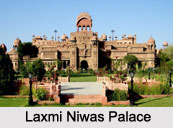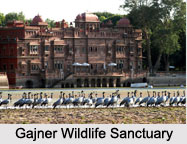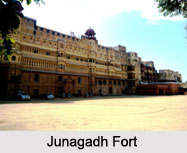 Tourism in Bikaner (in Bikaner District) of Rajasthan is dealing with the camel safari and desert camping in the midst of the Thar Desert, luxury stay and tour in Laxmi Niwas Palace, the pilgrimage tourism to Karni Mata Temple, the archaeological discoveries of Kalibangan and last but not the least the panorama of Junagadh Fort.
Tourism in Bikaner (in Bikaner District) of Rajasthan is dealing with the camel safari and desert camping in the midst of the Thar Desert, luxury stay and tour in Laxmi Niwas Palace, the pilgrimage tourism to Karni Mata Temple, the archaeological discoveries of Kalibangan and last but not the least the panorama of Junagadh Fort.
Laxmi Niwas Palace
Laxmi Niwas Palace is a palace and now served as a luxury hotel in Bikaner. It was the residential place of the kings of Bikaner and their families. Laxmi Niwas Palace was designed in the year 1896. It was built in an Indo-Saracenic style by the British architect, Sir Samuel Swinton Jacob. It was erected between 1898 and 1902.
Karni Mata Temple
 Karni Mata Temple is a well-known tourist place of religious importance. It is located at a distance of 30 kilometers from Jodhpur. The goddess is considered the patron Goddess of the Bikaner dynasty. She is believed to have blessed and guided Rao Bika in establishing his kingdom. This temple of Bikaner has massive silver gates that had been donated by Maharaja Ganga Singh. The panel of the gate depicts the patron goddess, with head of the demon Mahishasura, at the end of her trident. The temple is said to be 600 years old. The striking feature of this temple is the presence of numerous rats. It provides a haven to the rats (also called kabas) who are fed on the offerings of the devotees and run freely all over the temple complex.
Karni Mata Temple is a well-known tourist place of religious importance. It is located at a distance of 30 kilometers from Jodhpur. The goddess is considered the patron Goddess of the Bikaner dynasty. She is believed to have blessed and guided Rao Bika in establishing his kingdom. This temple of Bikaner has massive silver gates that had been donated by Maharaja Ganga Singh. The panel of the gate depicts the patron goddess, with head of the demon Mahishasura, at the end of her trident. The temple is said to be 600 years old. The striking feature of this temple is the presence of numerous rats. It provides a haven to the rats (also called kabas) who are fed on the offerings of the devotees and run freely all over the temple complex.
Gajner Wildlife Sanctuary
Gajner Wildlife Sanctuary is situated 32 kilometers away from Bikaner. It is location the way to Jaisalmer Road. Gajner was once the hunting preserve of Maharaja Ganga Singh. This wildlife park is surrounded by scrub forest. There is a lake within this sanctuary. It offers the perfect place to watch out for the chinkara, black buck and nilgai. The tourists will also be able to see antelope, gazelle and pigs arriving to drink water at the lake. The lake also attracts migratory birds from distant Siberia and other places in winter.
Gajner Palace
Gajner Palace served as a summer resort for the Maharaja of Bikaner. The buses from Bikaner are available for the sanctuary and the tourists will have to disembark at the village Galari. 
Camel Breeding Farm
Camel Breeding Farm is located at a distance of 8 kilometers from Bikaner. This government-managed camel breeding farm is only one of its kinds in Asia. One can get acquainted with this indispensable ship of the desert at this camel breeding and research station.
Kalibangan
Kalibangan derives its name from the numerous pieces of terracotta bangles of Indus Valley Civilisation and Harappa Era that were found scattered all over the excavation site. The excavations have revealed well-planned towns with streets that intersected at right angles and an advanced drainage system. It has also been discovered that the houses were made of bricks and used terracotta pipes in the bathrooms.
Junagarh Fort
Junagarh Fort is a medieval and early modern era fort of the 20th century. It served as the residential palace till the family of Bikaner moved to Lalgarh Palace. Junagadh Fort has the red sandstone and marble sculptures.
Visiting Information
The local transportations, such as, auto rickshaws and taxis are easily available in Bikaner to drop in at the places of interest around Bikaner. Bikaner is connected with road and railheads with other cities of Rajasthan, cities of Gujarat and cities of Maharashtra.



















